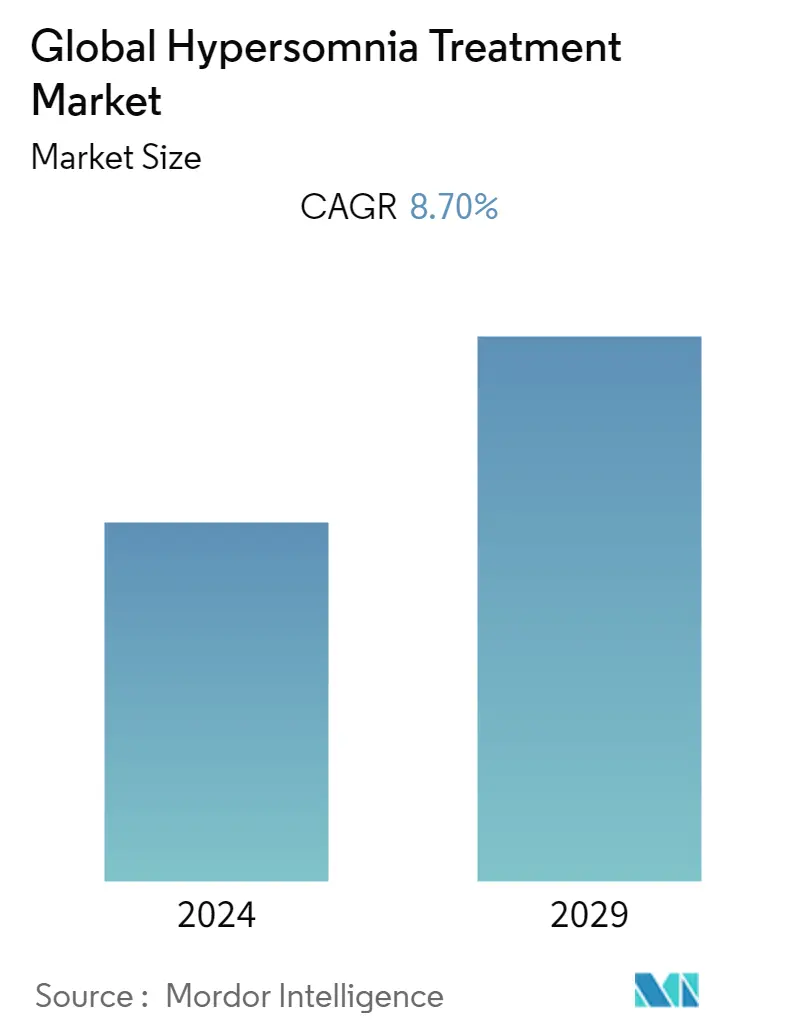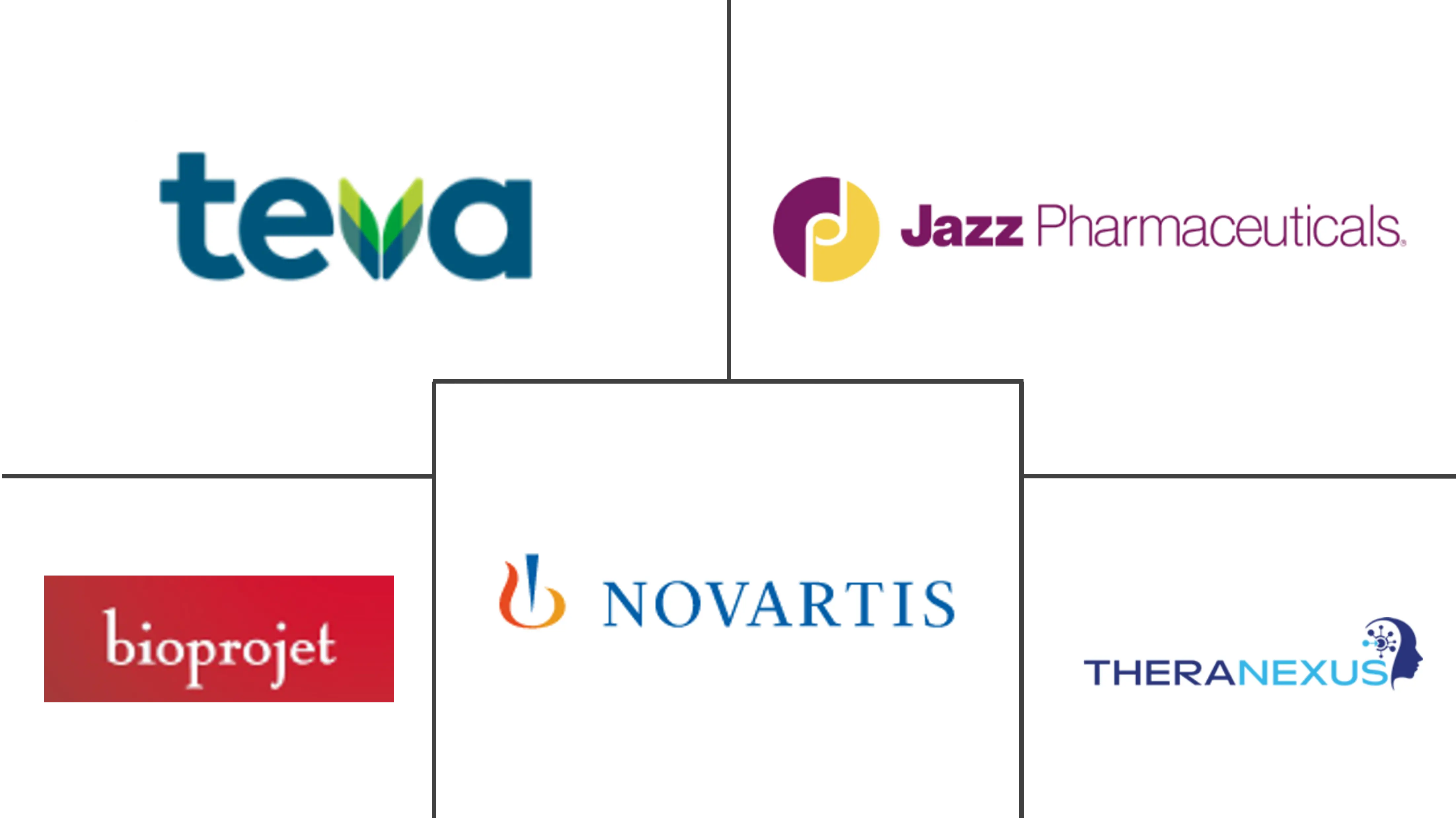Market Size of Global Hypersomnia Treatment Industry

| Study Period | 2019 - 2029 |
| Base Year For Estimation | 2023 |
| Forecast Data Period | 2024 - 2029 |
| CAGR | 8.70 % |
| Fastest Growing Market | Asia-Pacific |
| Largest Market | North America |
Major Players
*Disclaimer: Major Players sorted in no particular order |
Hypersomnia Treatment Market Analysis
The Hypersomnia Treatment market is projected to register a CAGR of 8.7% during the forecast period (2022 - 2027).
Since the COVID-19 pandemic, the proportion of sleeping disorder complaints has risen drastically. The sleep disorders were characterized as intrinsic (arising from the body), extrinsic (due to environmental conditions), or disturbances to circadian rhythm. The social isolation and interruption of daily routines during the COVID-19 lockdown have caused a rise in psychological stress among people, which in turn has increased sleep disorders all over the world. An article presented in the Journal of Clinical Sleep Medicine in February 2021 deduced that around 40% of the general and healthcare populations had reported various sleep problems during the COVID-19 pandemic. Excessive daytime sleepiness because of varied bedtime schedules is also one of the major causes of hypersomnia. Thus, there is an increasing demand for the hypersomnia treatment market to prevent further sleep disorders that arise due to COVID-19.
The Sleep Foundation (a Onecare Media Company), in its March 2022 article on 'Sleep Guidelines During the COVID-19 Pandemic', described the various factors associated with the sleep disorders during COVID-19 include infection and COVID-19, disruption of daily life, caregiving, excess screen time, anxiety and worry, depression and isolation, stress and stress-related fatigue, and altered dreams. According to an article published in December 2021 in the Egyptian Journal of Neurology, Psychiatry, and Neurosurgery, post-COVID-19 sleep disturbances were commonly reported in the recovery period. Also, these sleep deficits had an impact on the physical and mental aspects of quality of life.
The increased diagnosis of hypersomnia cases is a major driver which is anticipated to boost the growth of the market. Several organizations, such as the National Center on Sleep Disorders Research, have advocated the need to address the growing concern. According to the Cigna Health and Life Insurance Company's (CHLIC) April 2020 article, it was observed that the sale of sleep disorder prescriptions increased by 14.8% from February 16 to March 15 of the year compared to the same period in 2019. The surge in the development of pipeline drugs and the increase in lifestyle diseases, especially anxiety and depression, are expected to propel the growth of the market in the forecast period. However, the side effects of sleep disorder drugs are expected to limit the growth of the market.
Hypersomnia Treatment Industry Segmentation
As per the scope of this report, Hypersomnia is a condition that refers to excessive daytime sleepiness, where the patient has difficulties staying awake. The Hypersomnia treatment market is segmented by Application (Idiopathic Hypersomnia, Narcolepsy Type-1, Narcolepsy Type-2), Product (Antidepressants, Stimulants, Sodium oxybate, and Others), and Geography (North America, Europe, Asia-Pacific, Middle-East and Africa, and South America). The report offers values (in USD million) for the above segments.
| By Application | |
| Idiopathic Hypersomnia | |
| Narcolepsy Type-1 | |
| Narcolepsy Type-2 |
| By Product | |
| Anti depressants | |
| Stimulants | |
| Sodium oxybate | |
| Others |
| Geography | |
| North America | |
| Europe | |
| Asia-Pacific | |
| Middle-East and Africa | |
| South America |
Global Hypersomnia Treatment Market Size Summary
The hypersomnia treatment market is experiencing significant growth, driven by an increased prevalence of sleep disorders following the COVID-19 pandemic. The pandemic has exacerbated issues such as psychological stress, disrupted daily routines, and altered sleep patterns, leading to a rise in hypersomnia cases. This surge in diagnoses has heightened the demand for effective treatments, including stimulants like modafinil and solriamfetol, which are designed to improve wakefulness and address excessive daytime sleepiness. The market is characterized by a competitive landscape with major players such as Takeda Pharmaceutical Company, Teva Pharmaceuticals, and Jazz Pharmaceuticals leading the charge. These companies are actively involved in research and development, aiming to introduce novel therapies and expand their market share.
The market's growth is further supported by increased awareness of sleep disorders and the impact of lifestyle-related diseases, particularly in regions like North America. The National Sleep Foundation and other organizations have highlighted the importance of addressing sleep health, prompting investments in research and healthcare solutions. Regulatory approvals and clinical trials for new treatments, such as the Orphan Drug Designation for Mazindol ER and the Phase 3 trial for pitolisant, underscore the dynamic nature of the market. Despite the promising growth prospects, the market faces challenges, including the potential side effects of sleep disorder medications, which may limit its expansion. Nonetheless, the ongoing advancements in treatment options and the growing recognition of hypersomnia's impact on quality of life are expected to drive the market forward.
Global Hypersomnia Treatment Market Size - Table of Contents
-
1. MARKET DYNAMICS
-
1.1 Market Overview
-
1.2 Market Drivers
-
1.2.1 Increasing Awareness about Hypersomnia
-
1.2.2 Increase in Development of Pipeline Drugs
-
-
1.3 Market Restraints
-
1.3.1 Reduction in Diagnosis during COVID-19 Pandemic
-
1.3.2 Side Effects of Sleep Disorder Drugs
-
-
1.4 Porter's Five Forces Analysis
-
1.4.1 Threat of New Entrants
-
1.4.2 Bargaining Power of Buyers/Consumers
-
1.4.3 Bargaining Power of Suppliers
-
1.4.4 Threat of Substitute Products
-
1.4.5 Intensity of Competitive Rivalry
-
-
-
2. MARKET SEGMENTATION (Market Size by Value - USD million)
-
2.1 By Application
-
2.1.1 Idiopathic Hypersomnia
-
2.1.2 Narcolepsy Type-1
-
2.1.3 Narcolepsy Type-2
-
-
2.2 By Product
-
2.2.1 Anti depressants
-
2.2.2 Stimulants
-
2.2.3 Sodium oxybate
-
2.2.4 Others
-
-
2.3 Geography
-
2.3.1 North America
-
2.3.2 Europe
-
2.3.3 Asia-Pacific
-
2.3.4 Middle-East and Africa
-
2.3.5 South America
-
-
Global Hypersomnia Treatment Market Size FAQs
What is the current Global Hypersomnia Treatment Market size?
The Global Hypersomnia Treatment Market is projected to register a CAGR of 8.70% during the forecast period (2024-2029)
Who are the key players in Global Hypersomnia Treatment Market?
Teva pharmaceuticals Ltd. , Jazz pharmaceuticals Ltd., Bioprojet, Novartis AG and Theranexus are the major companies operating in the Global Hypersomnia Treatment Market.

